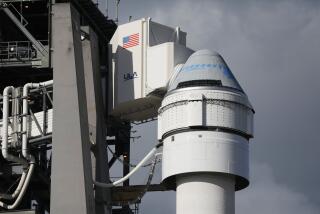Between Big Science and Big Dumb Science : What’s at stake with super collider and space station issues
- Share via
As Times writer Edwin Chen reported recently, one of the trendy questions in Washington these days is: “Does America really need Big Science?” That is the sort of rhetorical swagger that federal insiders assume when they know some big game is afoot but don’t quite know what. They don’t get forever to find out. A far more serious question, with a more crucial bearing on the country’s future, would be: “Does Big Science really need America?” For that matter, does science of any size really need America? The answer takes on substance when you consider that the Soviet Union did not wait for America when it built and launched its first space station years ago. Most scientists consider manned space operations more stunt flying than science, but a U.S. space station is one of $160 billion worth of projects in the pipeline that provokes the question about Big Science.
Europe did not wait for America when it built the world’s largest atom smasher near Geneva. Europe may well not wait to build a new device for the accelerator that would allow it to do much of what America’s super collider, near Dallas, will be able to do--if indeed Congress does not stifle the Dallas project by insisting that Europe chip in billions of dollars to help build it.
What the trendy Washington question really means is: Does science really need all this money? The answer would be simple if the White House and Congress could get it through their heads that not everything that involves algebra is science and that never before in history has leadership in science been more a key to leadership in human affairs.
Manned space operations are much more expensive than unmanned operations and, dollar for dollar, contribute far less to scientific advances. So it must have sent scientists through the roof not once but twice to hear the space station Freedom described in recent debate as the nation’s “steppingstone to the planets.” The nation has already been to the planets with unmanned space vehicles, most recently with breathtaking coverage of Venus by the cameras of the space probe Magellan.
The space station has been compromised and redesigned so many times during the last eight years that there is virtually no science left in it. Its most important contribution would be as a platform on which to study the effects of prolonged weightlessness on the human body and the implications of those effects for a manned trip to Mars. But the Soviets have been studying weightlessness for years. The space shuttle Columbia is on just such a mission now; other shuttles could do the same research.
The space station will cost $30 billion. Think of the fleet of satellites that sum would buy for measuring oceanic and atmospheric temperatures to speed up analysis of the greenhouse-effect theory. Think of what it would mean to all human beings to know as soon as possible whether they are changing their planet’s climate in sinister ways.
The $11-billion super collider, whose budget was cut by half by the House recently, comes perhaps more quickly to mind as Big Science than most projects, but it at least has the virtue of being science. It also illustrates a process that has been going on since Galileo’s first telescope, which compared to everything that went before it was big science. Talking to a convention of scientists earlier this year, President Bush said that “the power of knowing is the greatest pursuit.” The super collider’s great pursuit would be to track down the tiniest fragments of matter in the universe and either settle the question of what holds all of the fragments in place or set off a whole new sequence of theory and testing.
Washington will let scientists in other countries take the lead in such great pursuits of knowledge at the peril of a universal realization that science may indeed not really need America.






